Finding the right freelance content writer is a three-part process:
- You look for the right writer in your company
- You qualify the writer to check for quality
- You contact the writer and start working
Both steps are equally important whenever you hire a writer, whether freelance, part-time, or full-time. The process is neither a long nor a complex process, but you must do it in order to avoid any potential problems.
Let me show you the exact process I’ve used to find amazing writers for some of my clients’ companies and the six questions I ask them to qualify them.
(And be sure till the end because I’ve got a nice extra bonus for you.)
Part #1: Implement the Breadcrumbs Technique
As I’ve explained in my Copy Hacker’s article, the Breadcrumbs Technique consists in searching for high-quality content first and then contacting the writer who wrote it.
This technique, while not revolutionary in any sense, represents a contrasting change to the typical process most companies take, which is:
- Go to a marketplace, like Upwork or ProBlogger
- Put a listing
- Get spammed to death
- Go through the hundreds of applicants to find the one they like
- Qualify the writer further
- Hire the writer
You can find amazing writers in those marketplaces — I know I have. But the process is too costly; you spend hours going through the applicants, most of whom end up being irrelevant.
The Breadcrumbs Technique helps you start with the end in mind — high-quality content — and then reverse engineer the process to get the writer who is behind the given piece of content.
Here’s how you can implement the Breadcrumbs Technique:
Step #1: Find High-Quality Content
This is the most important step of the whole process because the quality of the content you find will determine the quality of the writer who conceived that piece.
Fortunately, it’s not hard to implement. You only need to find great content and you are done!
There are six methods I recommend to find top content in your industry:
Method #1: Search in your bookmarks
Take a look at your browser’s bookmark list and see what articles you’ve saved. It’s likely you will find many articles that you have found to be high-value for you.
Open all the articles you have in your bookmarks (at least those related to your industry).
(Quick tip: If you’re using Mac, press the command + shift + B letter buttons and automatically you’ll be taken to the bookmark page.)
Now, look at who wrote each of those pieces of content. In most cases, the author will be shown either at the beginning or at the end of the article.
Finally, copy the authors of those articles, and add them to an Excel sheet.
Method #2: Search your Twitter feed
There’s a high chance you tweet everything you enjoy reading related to your industry. For that reason, you want to scout your Twitter feed for content.
In your Twitter feed, look at the tweets related to the content you want to create.
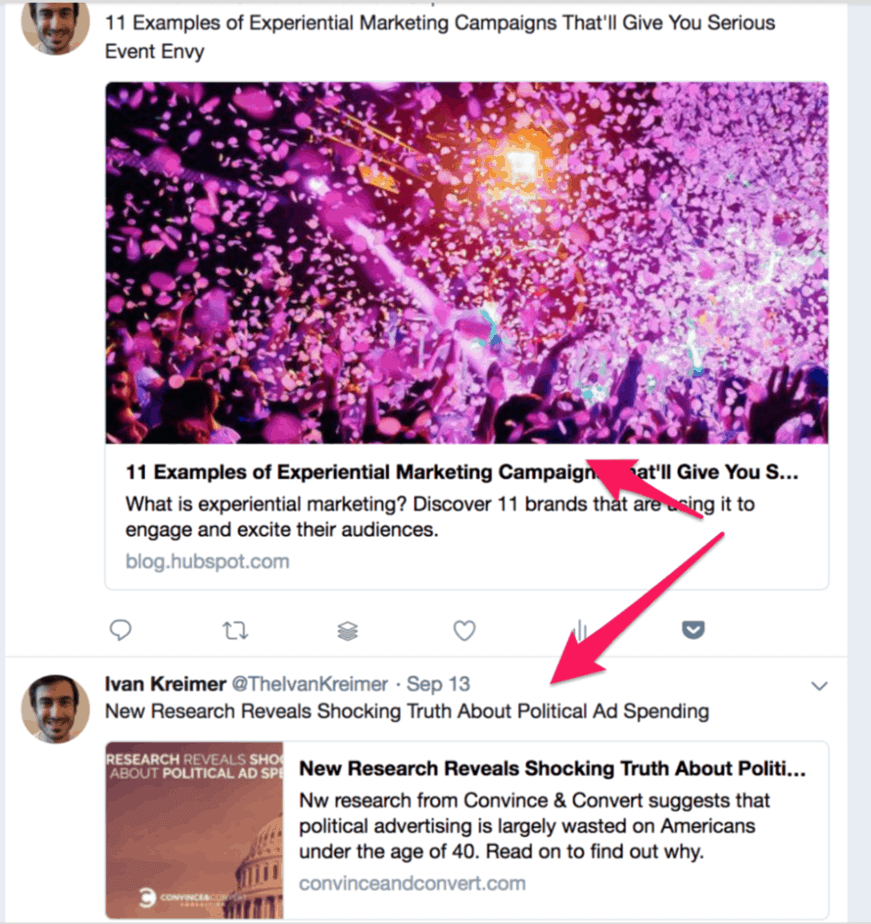
Open all the links that you find relevant. Then look for the writers of those pieces.
Just as before, make a list of all the writers that you find.
Method #3: Search in BuzzSumo and Ahrefs
BuzzSumo and Ahrefs are two amazing tools that allow you to find the total social shares of a given piece of content (in the case of BuzzSumo) or its backlink profile (in the case of Ahrefs). With these tools, you’ll search for content that has been shared and linked to many times, and see who wrote that content.
First, let’s go to BuzzSumo and search for a keyword related to your industry.
Let’s suppose you wanted to create content about improving security in the cloud industry and you used the keyword “cloud security concerns”:

Click the “Go” button and you’ll be taken to the results page, where you’ll find a long list of articles that have the most shares in the past year.
While this example doesn’t provide with content that has had many shares, they must be a lot for this industry.
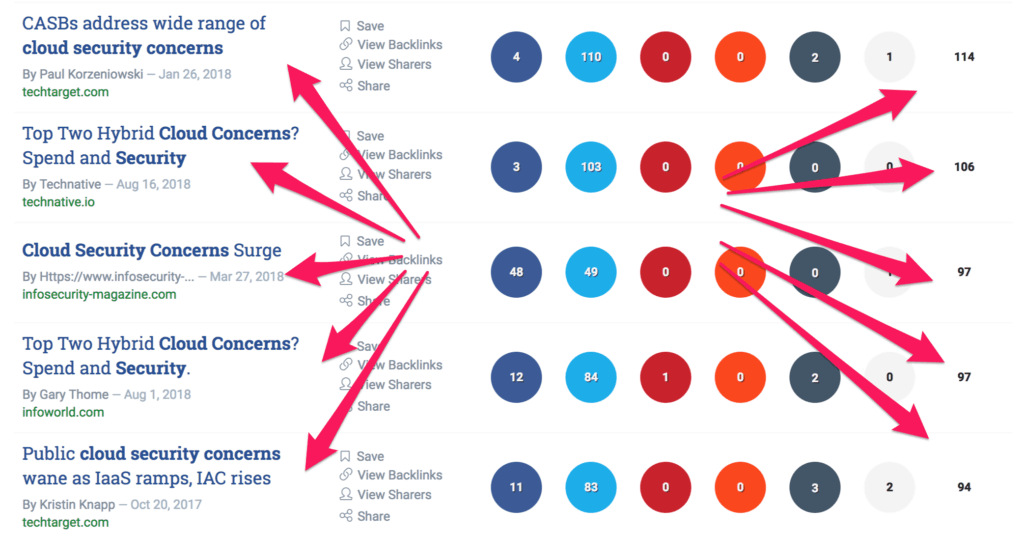
Check the top 10-20 results and write the names of writers you’ll later contact. By now, you may start to find some names repeat.
Next, go to Ahrefs and repeat the same process. Add the keyword in the search bar from the “Content Explorer” page:

You will found a list of articles with the most shares and, most importantly, with the most inbound links.
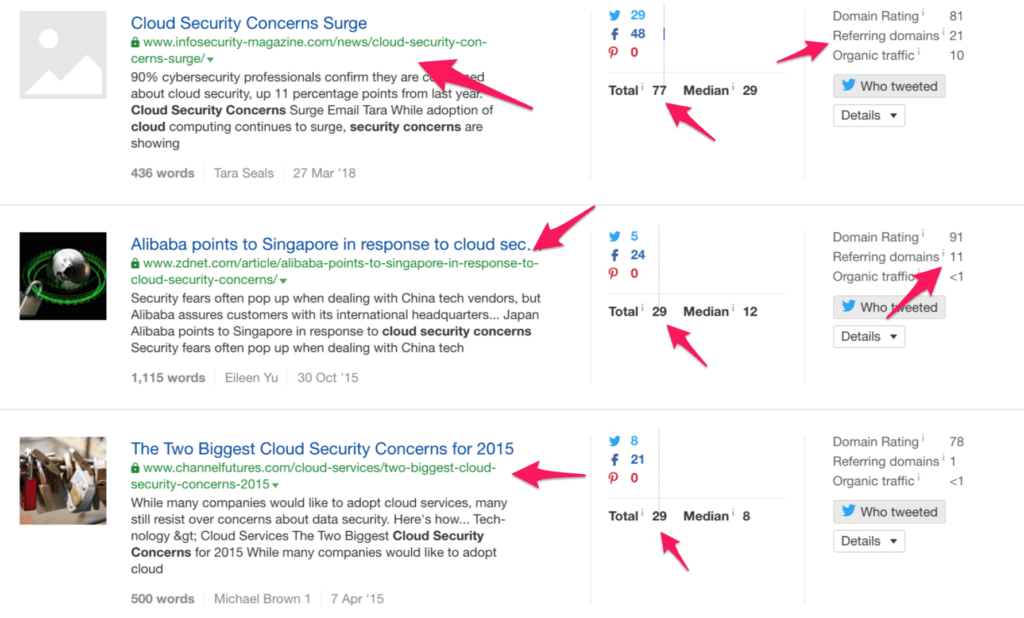
Once again, analyze the writers who wrote those articles and add them to your list.
Method #4: Search in groups and forums
People like sharing popular content in social groups. Two particularly great places to find content are Facebook groups and Reddit.
In both sites, you’ll add a broad keyword — which in our case will be “cloud security” — in the search bar.
In this example, there seems to be only one group around this topic. While it’s not great, it’s better than nothing.

If you wanted to find more results, use other broader keywords, which in our case could be “IT security,” “cloud computing,” or “data security.”
Repeat the process in Reddit.

As you can see, there’s a small subreddit in this topic, but two larger ones in two related topics. Click “See More” to find more related subreddits.
In both cases, enter in each of the groups you found and see the content that’s most popular and shared. As you already learned, your goal is to find the writers who wrote those pieces.
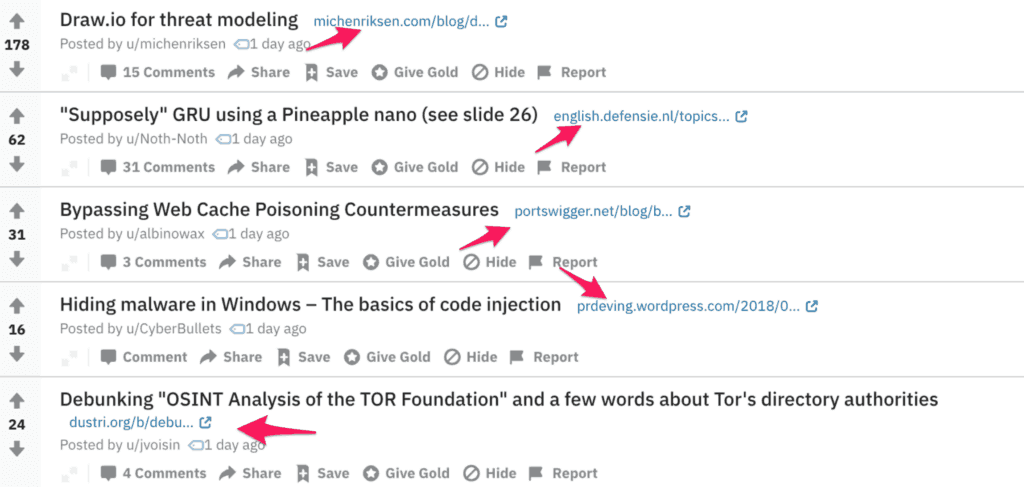
Method #5: Spy on your competitors
As it always happens, if your competition wrote popular content, the writer who developed such a piece must be good. In those cases, you’d want to try to hire that same writer, regardless of the fact she works for your competition.
Just go to your competitors’ blogs and check the writers.
Method #6: Ask friends and referrals
The final method is the easiest: ask people you know for quality writers.
Go to LinkedIn and ask people you know for an introduction to a writer they know and with whom have worked.
To do this, use the following template:
Hey [NAME],
I’m looking for a quality writer for [YOUR COMPANY]. Do you know anyone you trust that you could referred me to?
Any help is highly appreciated.
Cheers,
[YOUR NAME]
If you already know the writer with whom you want to work, change the question to “can you introduce me to [WRITER’S NAME]? I love his/her work and I was wondering if he/she could work with [YOUR COMPANY]?“
Step #2: Vet the Writer
Now that the research work is done, you should have a list of a few writers you like. Before you start contacting them, I recommend you vet them to make sure they are freelance writers and not a marketer who happens to like writing.
For example, if you like to read about chatbots, a few searches would show you Larry Kim is a top writer for many articles.

Unfortunately, he’s also the CEO of MobileMonkey, which means his writing services aren’t for sale.
On the other hand, if you check my bio, you’ll see right away I’m a freelance content marketer, which means I’m available for work.

Take a look at your list of writers. Here’s what you’ll need to do now:
- Look for the writer’s LinkedIn and Twitter profiles
- Hunt down their personal website
- See if they mention freelancing or writing services in their profiles or their website
For example, in my case, my Twitter profile doesn’t mention the fact I’m a consultant, but my LinkedIn’s profile description does.
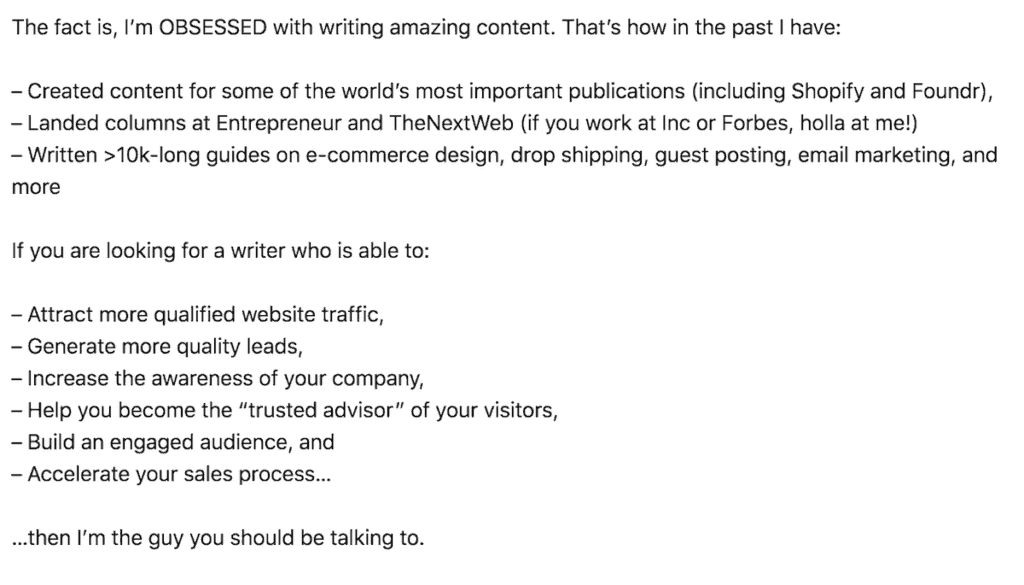
What’s more, you can see in the top menu of this site that I advertise my services.

With this simple analysis, you can already uncover the fact I’m a writer for hire. In many cases, like the example of my friends Ryan Robinson or Tomas Laurinavicius, you can see they’re not for hire (at least they don’t make it publicly).
While you can contact all the writers in your list, it’s best if you know their availability beforehand.
Step #3: Contact the Writer
Do you know what all high-quality writers have in common? They have more clients they can handle.
High-quality writers more often than not reject new clients if they don’t fit their ideal customer profile.
Consequently, you must be sure to contact the writers knowing you must convince them of working with you.
Here’s a template you can use to get your writer’s attention and respect:
Hi [WRITER’S NAME],
I’m [NAME], and I’m [ROLE] at [COMPANY], a company that [VALUE PROP].
I’ve seen your work on [SITE] and I loved it. I liked how well you explained [TOPIC].
At [COMPANY], we’re looking to ramp up our content, and since you’re such a fantastic writer, we’d love to help us.
I’d like to discuss this opportunity further somewhere late this week. How does [DATE + TIME WITH TIME ZONE] work for you?
Have a great day,
[NAME]
P.S.: If you’re not available for work, do you know anyone who could help us?
A few comments on this template:
- You start by introducing yourself and your company
- You explain the core purpose of your company — your value proposition
- You make the pitch relevant to the writer’s previous work
- You give a specific time to meet, making their decision easy
- You use a PS because there’s a high chance you missed finding some top writers the one you contacted knows and who can introduce you to
When everything is said and done, a top freelance content writer is like any other great expert: someone you must treat with care.
Part #2: Qualify the Freelance Writer
Once you’ve found the writer, it’s time to qualify him (or her) to make sure you’ve got someone who’s 100% aligned with your company.
It’s easy to overlook this process and to check the content written before and leave it at that, but this would be a mistake.
Take the time to ask the right questions, and you’ll get the right writer.
Here are the six questions I recommend you ask (and the answers you should hope to get).
Qualifying Question #1: What’s your writing process like?
This is a basic question that lets you find out two important aspects of the writer:
- How well he can answer an ambiguous question
- How clearly he can explain his process
In a way, this question is tricky, because the answer will depend on the type of content to develop, the way the client works, and the topic at hand.
A good way to think about the answer is to consider your past experience (if you have any).
- How did things go in the past?
- What worked?
- What didn’t work?
- What did you like working with your previous writers?
Write the answers.
When you start working with a new writer, have a process that’s comfortable and useful. Even if the writer has his own process, you can make him adapt to it and work with it.
I’ve had clients who have asked me to send them well-research ideas first, while others send me every single detail of their articles so I didn’t have to waste any time researching.
Some had simple editing process (mainly because they liked my work as it was), and others were much more detailed and thorough.
By having an idea of your preferred writing process, you can have a much more efficient working relationship with the writer.
Right Answer
“I start by researching every idea, looking for stats and examples. Then, I create an outline. I send it to you. Once it’s approved, I write it, and in ~5 days I’ll send it your way. From there, I edit everything as needed.”
“I analyze what’s popular on BuzzSumo. I take a look at your site and your most popular blogs (which I find with BuzzSumo, Ahrefs, or your Google Analytics). From there, I do some brainstorming. I propose the ideas to you.
Once you define the one you like the most, I get started writing. I try to use all my favorite writing techniques, like adding examples, stats, and the like, until the article is super actionable and well-written. I send the first draft. We go over the edits, and when you think it’s done, you paste in on your WordPress.”
Wrong Answer
“Uhm, I don’t know. I start writing and I learn as I go.”
“I expect you to send me everything — topics, keywords, ideas, examples, etc. I just write.”
Qualifying Question #2: How do you research your content?
Research is paramount to any high-quality piece of content. An article that has nothing but rants and opinions can work for an authoritative person (think Rand Fishkin in the online marketing world or Jocko Willink in the leadership industry), but not for you.
Writers need to research their content because:
- You need to use statistics to give a basis to your statements
- You need to use examples to show what you mean when you explain an idea
- You need to quote other people, particularly experts, to give more substance to your ideas
One thing that separates great writers from a run-of-the-mill writer is their capacity to research every piece of content they published.
Let me tell you: research is a pain in the ass. It takes a lot of time to find a relevant stat, and even harder to find the real source from it. It’s hard to find examples. It takes me a third to half an article’s writing time to do research, but it’s worth it.
The steep difference between writers who charge $400 for an article (ahem, like me) and those who charge half of that is that the former takes a lot of time researching their content.
You want to know with some detail what they do in this respect. If the writer has already explained to you that in the previous question, you can skip it. Also, an even better way to see if the writer researches his content is to look at his previous content.
If you want to learn more about the writer’s research process, you can ask more questions, like:
- What are your favorite resources to quote?
- Do you check the original sources of your quotes?
- Do you reach out to experts to get a quote?
Right Answer
“I search in Google for stats and case studies, and from there I take the ones that best apply to what I’m writing. Sometimes I quote experts I reach out to as well.”
“I take a mix of my personal experiences,
Wrong Answer
“I just use what I already know.”
“I don’t have the time to do much research besides a quick Google search.”
Qualifying Question #3: How long does it take you to write an article?
This is an obvious question I’ve many times overlooked and which cost me many headaches.
The goal behind this question is simple: plan you content calendar. The better your writers follow the processes you’ve laid out — which include planning the promotion, developing graphics, and the like —, the easier it will be to make your content machine work efficiently.
As a writer, it’s hard to tell how much an article will take you. I’ve cases of articles whose outline (given by the client) ended up being too detailed, resulting in a longer-than-usual timeline.
In some other cases, I had to research a lot, ask questions to experts, and look for highly specific examples. Such cases represented delays in the content.
Plan for such cases. Better yet, talk to the writer honestly. Listen to what they tell you. Most importantly, be flexible with your deadline. Yes, they’re meant to be respected, but sometimes shit happens, like I said in the previous paragraphs.
Right Answer
“With research and editing (which includes adding examples, stats, and the like), it will take me one week from today, so if today is Monday, next Monday I’ll send you the first draft.”
“Most articles like this one take 1 week, so by mid-next week I’ll have it done.”
Wrong Answer
“I have no clue, I’ll figure it out.”
“1 day flat.”
Note: In this case, the writer is unprofessional and doesn’t research anything he writes. Run away.
“Between 2 to 4 weeks.”
Note: Unless the writer can justify her tight schedule, in my experience, a 1,500-word article, the standard length for most companies, doesn’t take more than 10 days, if so.
Qualifying Question #4: How many edits/revisions do you offer?
Shit will happen, that’s a fact.
In some cases, the content you receive will be great and will only need a few changes. In some others, the content will be a mess and will need heavy edits.
While the latter case is more common with lower quality writers who churn content (another reason to spend more money on your writers), you need to know how much edits or revisions the writer is willing to give.
Most writers will be willing to offer as many edits as possible. Some others offer a more specific amount of edits, like one or two, which are more realistic.
You will only need between one to three edits for most content, so when a writer says he offers “unlimited” edits, he means he wants you to be happy with the final draft.
In reality, if a standard article takes more than three edits, then the writer is doing a bad job at editing or you’re not clear on the edits. And that’s an important point to consider: don’t be picky and ambiguous with your edits.
How to edit content
My rule of thumb is this:
In the first edit, be general with the edits, focusing on the direction and tone of the article as a whole. For example, if you want a highly actionable tutorial on developing a simple WordPress plugin, tell the writer the article needs more actionable steps. Point some specific parts that are missing, and let the writer solve the rest.
In the following edits, you should get more specific. If one specific section of your tutorial is weak (e.g., it lacks images, it’s poorly written, etc.), add a suggestion pointing to that part of the article.
After three edits, the article should be ready to go. If it’s not, then the writer is doing a poor job — which you can discover based on the feedback you get — or you’re not being clear.
I had a situation where I client of mine spends a huge deal of time going through the edits for an 800-words article that, in my opinion, wasn’t going to drive results. (Anything 800-words long will rarely drive any results.) Her site wasn’t driving much traffic, and for the topic at hand, few people would care much about it either. That client was going over every single sentence and paragraph, overanalyzing and providing pointless suggestions which overrode previous edits.
Needless to say, I ditched to the client afterward. It wasn’t that I don’t like editing — it’s that editing is all about the reader, not the writer. As Stephen King says in On Writing:
When you write a story, you’re telling yourself the story,’ he said. ‘When you rewrite, your main job is taking out all the things that are not the story.
In other words, when you write, you write for yourself, putting everything you know on paper. When you edit, you edit so the reader can understand you.
People who “get” content know this (even without realizing it), and offer edits based on this idea. If you are spinning on your heels, you’re simply too complicated and don’t deserve my attention.
Before moving on, here’s an important final point of consideration:
The content you receive won’t be 100% as you’d wish it was if you had written it. Instead of demanding the writer to create something that fits exactly what you want, you have two options:
- Be clear upfront on what you want
- Make the necessary stylistic changes yourself
If you don’t tell the writer what you like and hope he gets it by himself, you will do both you and the writer a disservice.
Right Answer
“I offer up to three edits.”
“I offer unlimited edits — until you’re satisfied with the draft.”
Wrong Answer
“I don’t edit my content, you’ll have to do it yourself.”
Qualifying Question #5: Where have you written? Can you send me a portfolio?
Every good writer has a writing portfolio. They are their CV, their shield, and their 24/7 salesman.
When talking to a potential writer, ask for the portfolio.
Strangely enough, most writers I know have no portfolio.
(Writer to Writer Note: If you don’t have a portfolio yet, don’t be dumbass and use Contently.)
If that’s the case, they’re likely to send you a list of articles. To filter their content, ask the following question:
What content piece do you think relates to what we do?
Another great question which will uncover their personality and style is:
What content piece are you most proud of? Why?
You simply want to see what they’re capable of doing. If you have approached the writer, then you already have an idea of the writer’s content, so you can skip this part.
Still, I’ve found the two questions from above to be highly effective to find what the writer is all about — what she likes writing, how much she knows about your industry, what motivates her, and more.
Right Answer
“Yes, here’s the link.”
“Yes, and these are the best clips I can send you.”
Wrong Answer
“Uhm, no, but I have written for some sites before. Trust me, I’m great and super respectful with the deadline.”
“Yes, here’s 50 random links that aren’t suited to your company.”
Qualifying Question #6: Do you promote the content? If so, how?
Here’s the main difference between a content writer and a content marketer:
The former writers and does little to no promotion, while the latter does both.
While this article isn’t geared toward marketers, if you can get a writer to help you with the promotion, great.
This isn’t mandatory, but any proud writer would promote his content, even if that meant tweeting about it and send an email to his email list.
If they promote their content as a separate job, get to know more about it. Anything that can help you get more eyeballs towards your content is great news.
Right Answer
“Not necessarily, but I’m willing to help on whatever it’s needed. That may cost extra, but it depends. What did you have in mind?“
“Yes, I tweet and send an email to my list.”
Wrong Answer
“I’d never do that, I’m just a writer.”
“What’s promotion? Like buying a billboard?”
Part #3: If you like the writer, then what?
You’ve vetted the writer and you like her a lot. She seems professional, smart, and driven. Do you hire her right away? Do you send her a contract?
The first thing you should do: get a test article.
You must make sure there’s a right fit between both of you. You’ll probably hit it off very well as it happened with most of my clients.
Before you assign her an article, you need to send her your style guide. I love when clients send me style guides for the simple reason it makes my life much simpler.
If you haven’t developed one, then at least give her some pointers about your style, including the overall tone and your audience. Send her your favorite article and the most successful one. With both articles, she’ll have a much better idea what you like and what’s worked best for you.
You can send her an idea and, preferably, an outline, or you can ask her for some ideas.
For the first article, I’d highly recommend you guide her more than she guides you. The fewer things you leave it out to chance, the better it will be for everyone.
Sure, the writer should ask you some questions before she gets started as well as research your site to get a feeling of your style. But don’t count on that alone. Help her and she’ll give you something you’ll love.
Once you get the article back from the writer, take a look at the following aspects of her work:
- Timeliness: Did the writer send you the article on time?
- Responsiveness: Was the writer responsive to your contacts (if there were any)?
- Coherence: Was the article close to what you had requested?
- Quality: Do you think the article stands your quality’s bar? If not, why? How can the writer improve it?
- Revisions: How open was the writer for revisions? How did she respond to them?
If everything scores well, you can count on that writer for long-term work.
If things don’t go well, then it’s a red warning. I have the chance to work with some writers (who coincidentally were all quite cheap) who were eager to start working and ended up being completely unprofessional. If you have a bad hunch for your first article, move on to the next one in your list.
The worst thing you can do for yourself is work with a writer who you can’t trust. Repeat this process until you find a writer you like. If you pay your writers good rates (at least for what you expect to get), then you will find trustworthy writers.
Remember to keep the relationship going. If there are any downturns in your workload for whatever reason, contact the writer and let her know. Most companies with whom I’ve worked seem to treat writers like dispensable, and to be honest, it’s an awful experience.
Business is business, but honest business is great business.
Keep in touch with your writers, help them improve their content, and you’ll get amazing content consistently.
What You Need to Do Now
You now must be asking yourself, “is it necessary you ask all of these questions?” Not really. The point isn’t to interrogate a writer, but rather to find the key aspects of her work.
For example, if you already found strong writing pieces, you can skip the sixth question. But if you aren’t sure whether they’re willing to write about topics you predefined, you must get that mystery solved before you start working together.
At the end of the day, success comes from alignment.
The more aligned your freelance content writer is with you — your processes, your brand, your budget, etc. —, the better it will be for both of you. The same can be said about any other freelancer with whom you work.
Get on the same page your writer is, and you’ll get much better content.
Here’s a little gift for you
If you want to copy and paste the same questions I’ve used to vet the freelance writers I’ve hired, I got you covered.
I’ve developed a questionnaire you can copy and paste into your next job listing to pre-qualify your prospects. I highly recommend using these questions in a Typeform and have all your applicants go through them. You can ask deeper questions related to these ones later on.
You can also take these questions and run them next time you sit down in an interview with a potential freelance writer.
Whatever the case, download it and use it.
🎁 Free Bonus: Download the Checklist
